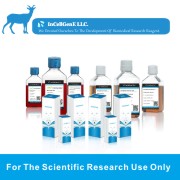

| Organism | Homo sapiens, human |
|---|---|
| Tissue | bone marrow |
| Cell Type | erythroblast |
| Product Format | frozen |
| Morphology | lymphoblast |
| Culture Properties | suspension |
| Biosafety Level |
1
Biosafety classification is based on U.S. Public Health Service Guidelines, it is the responsibility of the customer to ensure that their facilities comply with biosafety regulations for their own country. |
| Disease | erythroleukemia |
| Age | 35 years |
| Gender | male |
| Ethnicity | Japanese |
| Applications |
This cell line provides a good system for investigating the proliferation and differentiation of myeloid progenitor cells.
|
| Storage Conditions | liquid nitrogen vapor phase |
| Derivation |
The TF-1 cell line was established by T. Kitamura, et al. in October 1987 from a heparinized bone marrow aspiration sample from a 35 year old Japanese male with severe pancytopenia. -
|
|---|---|
| Clinical Data |
male
Japanese
35 years
|
| Comments |
The cells are completely dependent on interleukin 3 (IL-3) or granulocyte-macrophage colony-stimulating factor (GM-CSF) for long term growth. The cells DO NOT RESPOND to interleukin 5 (IL-5). TF-1 cells respond to a variety of other lymphokines and cytokines such as interleukin 1 (IL-1), interleukin 4 (IL-4), interleukin 6 (IL-6), interleukin 9 (IL-9),Interleukin 11 (IL-11), interleukin 13 (IL-13), stem cell factor (SCF), leukemia inhibitory factor (LIF) and nerve growth factor (NGF). TF-1 cells do not express glycophorin A or carbonyl anhydrase I. The morphological and cytochemical features, and the constitutive expression of globin genes, indicate the commitment of the cells to the erythroid lineage. Hemin and delta-aminolevulinic acid induce hemoglobin synthesis, and TPA induces dramatic differentiation of the TF-1 cells into macrophage-like cells. The TF-1 cell line is unique because of its responsiveness to multiple cytokines. |
| Complete Growth Medium |
The base medium for this cell line is ATCC-formulated RPMI-1640 Medium, Catalog No. 30-2001. To make the complete growth medium, add the following components to the base medium: 2 ng/ml recombinant human GM-CSF; fetal bovine serum to a final concentration of 10%. |
|---|---|
| Subculturing |
Cultures can be maintained by the addition of fresh medium. Alternatively, cultures can be established by centrifugation with subsequent resuspension at 2 X 104 viable cells/mL. Do not allow the cell concentration to reach 7 X 105 cells/mL. Corning® T-75 flasks (catalog #431464) are recommended for subculturing this product.
Interval: Maintain cultures between 3 X 104 and 5 X 105 viable cells/mL
Medium Renewal: Add fresh medium every 2 to 3 days (depending on cell density)
|
| Cryopreservation |
Freeze medium: Complete growth medium supplemented with 5% (v/v) DMSO
Storage temperature: liquid nitrogen vapor phase
|
| Culture Conditions |
Atmosphere: air, 95%; carbon dioxide (CO2), 5%
Temperature: 37��C
|


